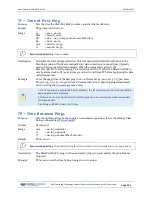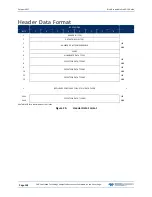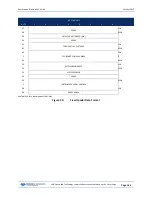
RiverPro and RioPro ADCP Guide
October 2017
EAR-Controlled Technology Subject to Restrictions Contained on the Cover Page.
Page 131
ZG – Vertical Beam Gain
Purpose:
Allows the RiverPro to reduce receiver gain by 40 dB.
Format:
ZGn
Range:
n = 0 (low), 1 (high)
Default:
ZG1
Recommended Setting.
The default setting for this command is recommended for most applications.
Description:
ZG0 tells the RiverPro to reduce receiver gain by 40 dB. This may increase data reliability
in shallow-water applications where there is a high content of backscatter material. ZG1
(the default) uses the normal receiver gain.
ZM – Vertical Beam Profile Mode
Purpose:
Selects the vertical beam profiling mode used by the RiverPro.
Format:
ZMn
Range:
n = 2, 12 (see description)
Default:
ZM2
Recommended Setting.
The default setting for this command is recommended for most applications.
Description:
The ZM command sets an application-dependent profiling mode. The chosen mode se-
lects the types of pings transmitted. The ping type depends on how much the water-cur-
rent is changing from ping-to-ping and from cell-to-cell.
ZM2 refers to water mode 2 (WM2) pings for the vertical beam profile ping. WM2 pings
are very similar to TRDI’s traditional WM1 pings, except that they use 8-bit sampling in-
stead of 1-bit sampling. These pings use a relatively short lag (i.e. large ambiguity veloc-
ity), and make the assumption that the velocities being measured will never rise above the
ambiguity velocity; i.e. there is no ambiguity resolving being done.
ZM12 is essentially the same type of measurement as ZM2, except that there are subpings
(the number being set by the
) being averaged together in the phase plane,
before the resulting average is converted from phase data to velocity. This has the effect of
increasing the effective ping rate (and thus, lowering standard deviation) in very low-dy-
namic environments. If the dynamics of the environment are too high (e.g. if the RiverPro
is bouncing around), ZM12 would tend to smear together data sampled at different orien-
tations, resulting in lower-quality measurements.
















































